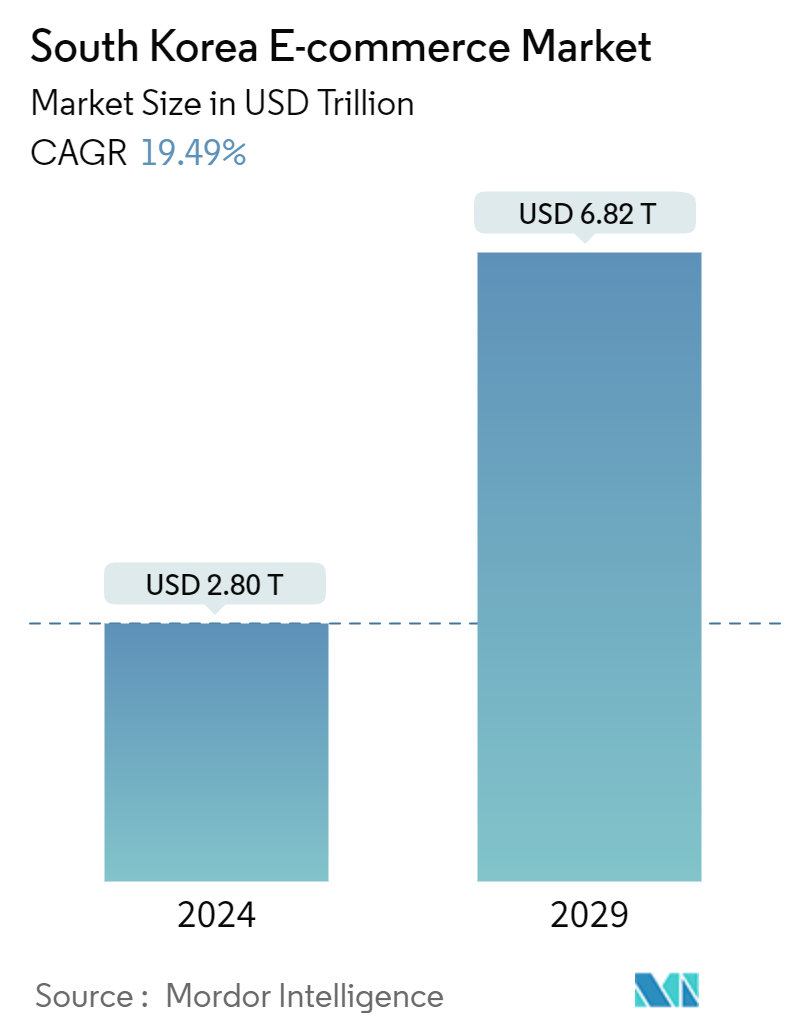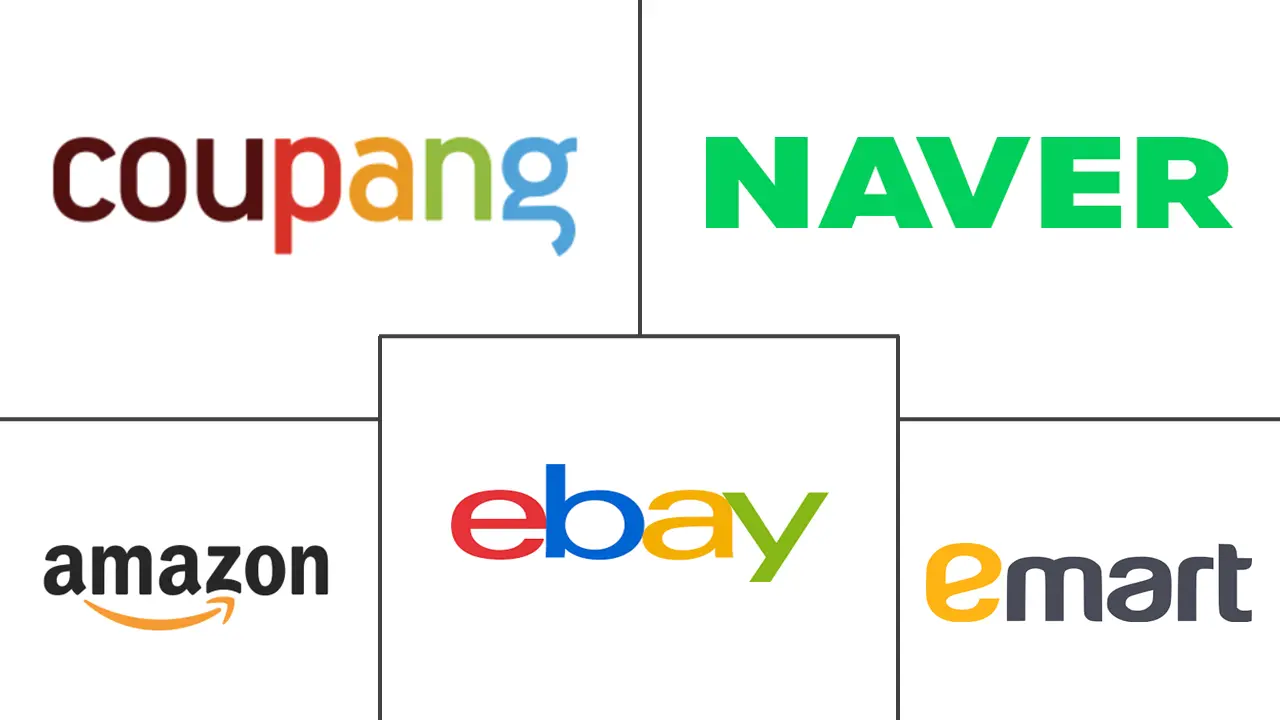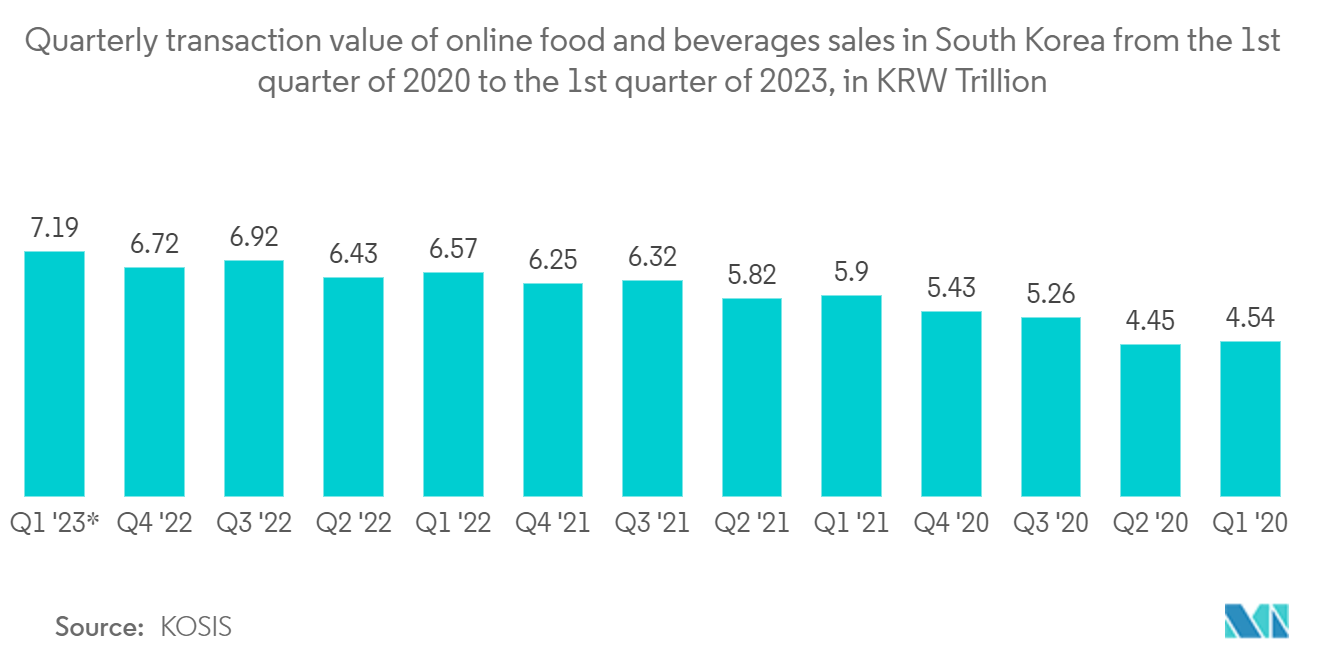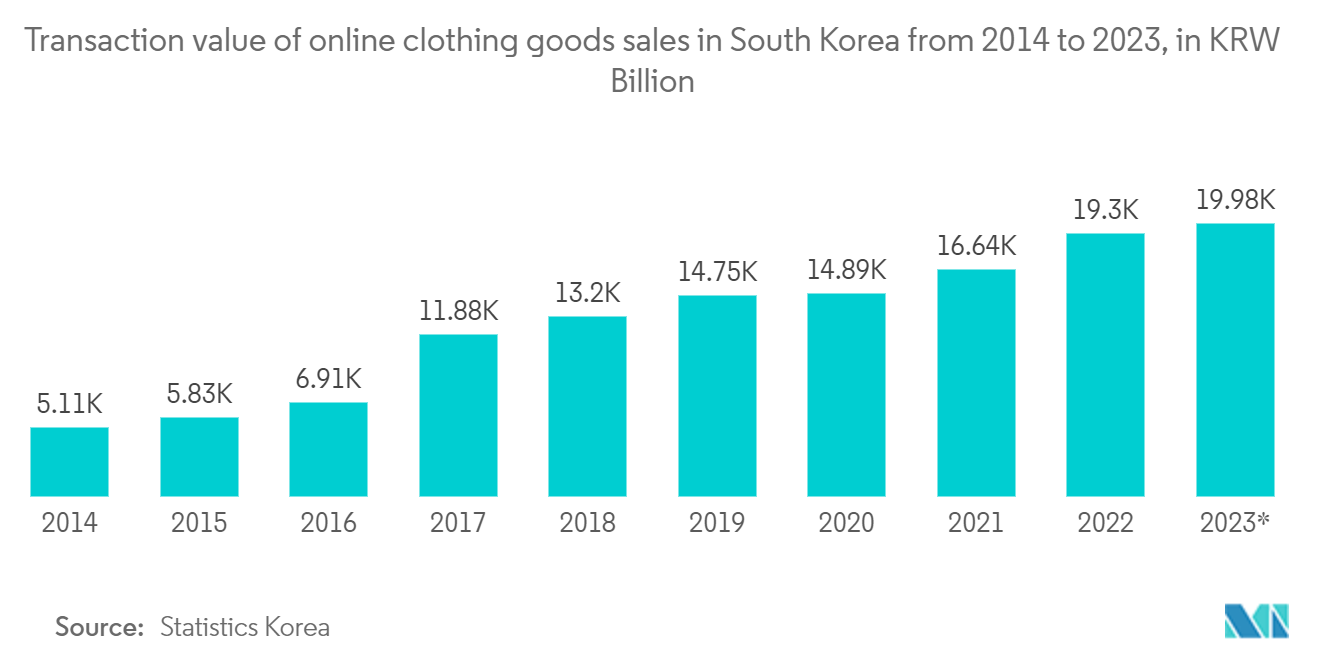South Korea E-commerce Market Size

| Study Period | 2019 - 2029 |
| Base Year For Estimation | 2023 |
| Market Size (2024) | USD 2.80 Trillion |
| Market Size (2029) | USD 6.82 Trillion |
| CAGR (2024 - 2029) | 19.49 % |
| Market Concentration | Low |
Major Players
*Disclaimer: Major Players sorted in no particular order |
South Korea E-commerce Market Analysis
The South Korea E-commerce Market size is estimated at USD 2.80 trillion in 2024, and is expected to reach USD 6.82 trillion by 2029, growing at a CAGR of 19.49% during the forecast period (2024-2029).
- The country's retail sector is being rewired by digitally inspired innovations that go beyond the channel shift. Owing to the COVID-19 pandemic, new business models gained traction, and commerce ecosystems evolved, altering how retailers and brands interacted with digitally connected audiences. The digital revolution resulted in a more convoluted and fragmented retail market during the previous decade. Marketplaces, direct-to-consumer brands, social commerce, live selling, and voice commerce are examples of the various paths to the end consumer, showing the growth adoption of e-commerce channel sales in the country.
- The International Trade Administration reported that e-commerce is a significant part of the country's entire consumer industry and is continually rising. Korea is a technologically advanced country, with about 99.96% of Korean households having an internet connection through a computer, mobile phone, or another device, as reported by the 2023 Ministry of Science and ICT report. This is expected to drive demand in the country's e-commerce sector.
- Electronic payment services via PC and mobile are becoming more popular as online shopping continues to develop. The average daily utilization of the Payment Gateway (PG) service based on credit cards exceeded 16 million. Furthermore, mobile payment and digital wallet services like Samsung Pay and Naver Pay are gaining popularity in South Korea, supporting the market’s growth.
- Additionally, the emergence of e-commerce platforms to support the increasing demand in the retail sector during and in the post-covid-19 pandemic period due to the shutdown of physical stores and social distancing guidelines is one of the significant factors in the growth of internet retailing, which impacted the market’s growth. Consumers in the country want a one-stop shopping experience that includes product reviews and prices, purchasing, and paying with new online payment solutions associated with the platforms. Internet portal sites, social network services, TV home shopping, and other platforms now have online shopping functions, and the popularity of their platforms is growing, supporting the growth trend of e-commerce in the country.
- The majority of people's time and money is spent online in South Korea, resulting in the rise in cybercrime and cyber dangers, which are unsurprising. As data theft and security breaches grow, so does the need to improve cybersecurity. Investing in more secure servers and checkout processes can remedy such issues. Consumers, above all, demand assurances about the security of their personal and financial data. Therefore, the risk of data security with the growth of the country's e-commerce sector is expected to be a market challenge during the forecast period.
South Korea E-commerce Market Trends
Food and Beverage Sector to Hold Significant Market Share
- Food and beverage e-commerce has benefited from the growing demand for online grocery shopping behavior changes in terms of food consumption, which were greatly influenced by reduced outdoor activities such as work from home and remote learning, supporting further strong growth for food and drink e-commerce, supported the growth of e-commerce platforms in the country.
- The transformation toward higher-density urban living in the country has led from communal dining to meal kits and on-the-go eating options. As convenience becomes a priority, meal kits with easy-to-follow recipes are increasingly popular, supporting the demand for packaged food and driving the growth of the e-commerce market in the country. Additionally, South Korean consumers are also taking note of the trend for healthier food options. Increasingly, consumers pay more attention to the quality, nutritional value, and sourcing of the food they consume, presenting opportunities for high-quality, ethically sourced, healthier food options. Further, South Koreans, having grown up with a distinctive and unique food culture, are traveling more and are developing an increased taste for international food and beverage products, supporting the e-commerce platform usage for food and beverages in the country during the forecast period.
- Furthermore, according to the Korean Statistical Information Service (KOSIS), the transaction value of online food and beverage purchases was roughly KRW 7.19 trillion (approximately USD 5.3 billion) in the first quarter of 2023, an increase in sales from the previous quarter, Q4 2022. Over the years, the transaction value has gradually grown. Such a significant transaction value is expected to considerably contribute to e-commerce growth in the country.
- The market has witnessed a significant increase in the internet channel's nationwide percentage of fresh food purchases. However, as consumers' meal preferences have evolved, they increasingly seek out different cuisines as substitutes for Korean-style recipes, buying fresh components such as imported meat and Western veggies or meal packages in small quantities. Such trends are considerably contributing to online food deliveries across various food chains, thereby driving e-commerce sales in the country.
- The accessibility of online grocery shopping is expected to retain current customers, as many of them have grown accustomed to having large grocery items brought to their homes. The growing number of single-person and dual-income households, which fueled the channel's growth before the pandemic, is expected to continue to be the primary driver. At the same time, the influx of new customers, such as older adults, is anticipated to accelerate the rapid growth of food and drink e-commerce over the forecast period.

Fashion and Apparel Sector to Register Significant Growth
- South Korea is now regarded as one of the East's most significant emerging fashion capitals, with Seoul Fashion Week becoming increasingly famous. Saturation in the West has caused many businesses to change their emphasis and seek out emerging markets, which is expected to develop the fashion and apparel industries in the country, thereby supporting market growth.
- Additionally, South Korea has an economically expanding fashion industry, with several local names accounting for a sizable portion of total fashion sales. Aside from that, Seoul has a powerful impact on street style, particularly among the younger groups.
- South Korea has its own set of patterns and retail and online players. Although there is a strong preference for Western luxury goods, customers in the nation have individual preferences for them. As a result, the strategy for reaching these consumers must be completely tailored to their preferences. South Koreans use a variety of social media applications, both prominent Western and local, which is expected to account for e-commerce revenue generation considerably.
- Additionally, local celebrities and pop icons also have a big influence on South Koreans. Moreover, many Western companies use these personalities as brand ambassadors. Their distinct style can influence public opinion and set significant national developments. These trends could potentially attract large players to invest in fashion e-commerce activities to enhance their offerings across the country.
- Consumer demands in the fashion market are becoming increasingly complicated and varied due to increased consumption and rising disposable incomes. Other factors include the growing desire for individuality and personalized fashion, the growth of life-enriching consumption such as leisure and cultural activities, an increase in internet sales, an aging population, and a change in core consumers. Such trends are expected to significantly increase e-commerce sales in the fashion industry.

South Korea E-commerce Industry Overview
The South Korean e-commerce market is fragmented, with the presence of major players like Coupang Corp., Naver Shopping, eBay Inc., Amazon.com Inc., and Emart. Players in the market are adopting strategies such as partnerships, innovations, mergers, investments, and acquisitions to enhance their service offerings and gain a sustainable competitive advantage. Furthermore, the growing popularity and adoption of e-commerce attract newer players to the market, thus increasing the competitive rivalry in the South Korean e-commerce market.
- April 2024: Amazon implemented a policy offering complimentary shipping for orders exceeding USD 49 worth of eligible items for delivery to South Korea, with the shipping address set within South Korea on its website, which includes shopping for small essentials and home appliances. This is expected to fuel the e-commerce industry’s growth in the country.
- March 2024: FedEx Express, a global logistics company, announced an alliance with eBay CBT (Cross Border Trade) to provide cross-border e-commerce logistics services for South Korean businesses looking to expand their footprint to overseas markets, which is expected to support the sale of foods through online channels in the country and fuel the market’s growth.
South Korea E-commerce Market Leaders
-
Coupang Corp.
-
Naver Shopping
-
eBay Inc.
-
Amazon.com Inc.
-
EMart
*Disclaimer: Major Players sorted in no particular order

South Korea E-commerce Market News
- March 2024: The South Korean e-commerce company Coupang Corp. announced an investment of USD 2.23 billion over the next three years to expand its "rocket delivery" service across South Korea by setting up over eight fulfillment centers to serve as logistical hubs for fast delivery to boost efficiency and reliability in its operations by leveraging advanced automation.
- March 2024: The Chinese e-commerce giant Alibaba Group planned to spend USD 200 million in 2024 on building the logistics center and USD 100 million to help small and mid-sized South Korean firms sell their products overseas, within its vision of investing USD 1.1 billion in South Korea over the next three years to build a logistics center and expand businesses, which shows the growth potential of the e-commerce sector in the country.
South Korea E-commerce Market Report - Table of Contents
1. INTRODUCTION
- 1.1 Study Assumption and Market Definition
- 1.2 Scope of the Study
2. RESEARCH METHODOLOGY
3. EXECUTIVE SUMMARY
4. MARKET INSIGHTS
- 4.1 Market Overview
-
4.2 Industry Attractiveness - Porter's Five Forces Analysis
- 4.2.1 Bargaining Power of Suppliers
- 4.2.2 Bargaining Power of Buyers
- 4.2.3 Threat of New Entrants
- 4.2.4 Threat of Substitute Products
- 4.2.5 Intensity of Competitive Rivalry
- 4.3 Key Market Trends and Share of E-commerce of Total Retail Sector
- 4.4 Impact of COVID-19 on the Market
5. MARKET DYNAMICS
-
5.1 Market Drivers
- 5.1.1 High Smartphone and Internet Penetration Across the Country
- 5.1.2 High Demand for Food Delivery Services
-
5.2 Market Challenges
- 5.2.1 Data Security
- 5.3 Analysis of Key Demographic Trends and Patterns Related to E-commerce Industry in South Korea
- 5.4 Analysis of the Key Modes of Transaction in the E-commerce Industry in South Korea
- 5.5 Analysis of Cross-border E-commerce Industry in South Korea
- 5.6 Current Positioning of South Korea in the E-commerce Industry in Asia-Pacific
6. MARKET SEGMENTATION
-
6.1 By Type
- 6.1.1 B2C E-commerce
- 6.1.1.1 Application
- 6.1.1.1.1 Beauty and Personal Care
- 6.1.1.1.2 Consumer Electronics
- 6.1.1.1.3 Fashion and Apparel
- 6.1.1.1.4 Food and Beverage
- 6.1.1.1.5 Furniture and Home
- 6.1.1.1.6 Other Applications
- 6.1.2 B2B E-commerce
7. COMPETITIVE LANDSCAPE
-
7.1 Company Profiles*
- 7.1.1 Coupang Corp.
- 7.1.2 Naver Shopping
- 7.1.3 eBay Inc.
- 7.1.4 Amazon.com Inc.
- 7.1.5 EMart
- 7.1.6 Interpark.com
- 7.1.7 Tmon Inc.
- 7.1.8 11Street Co. Ltd
- 7.1.9 SSG.com Corp.
- 7.1.10 Apple Inc.
8. INVESTMENT ANALYSIS
9. FUTURE OF THE MARKET
** Subject To AvailablitySouth Korea E-commerce Industry Segmentation
E-commerce refers to selling clothing, electronics, furniture, books, cosmetics, and other items over the Internet. Companies that provide home delivery services, such as e-commerce and m-commerce, are included in this industry. Retailers and their consumers conduct sales transactions using information technology, such as the telephone and the Internet, and merchandise is often delivered via mail or courier. Direct mailers that sell their merchandise and retail through online websites are also included in the e-commerce industry.
The e-commerce market for the study defines the revenues generated from B2C e-commerce and B2B e-commerce in South Korea. The study is segmented by type (B2C e-commerce {application [beauty and personal care, consumer electronics, fashion and apparel, food and beverages, furniture and home, and other applications]}, and B2B e-commerce). The market sizes and forecasts are provided in terms of value in USD billion for all the segments. The analysis is based on the market insights captured through secondary research and the primaries. The report tracks key market parameters, underlying growth influencers, and major vendors operating in the industry, which supports market estimations and growth rates over the forecast period. The market sizes and forecasts are provided in terms of value (USD) for all the segments.
| By Type | B2C E-commerce | Application | Beauty and Personal Care |
| Consumer Electronics | |||
| Fashion and Apparel | |||
| Food and Beverage | |||
| Furniture and Home | |||
| Other Applications | |||
| By Type | B2B E-commerce |
South Korea E-commerce Market Research FAQs
How big is the South Korea E-commerce Market?
The South Korea E-commerce Market size is expected to reach USD 2.80 trillion in 2024 and grow at a CAGR of 19.49% to reach USD 6.82 trillion by 2029.
What is the current South Korea E-commerce Market size?
In 2024, the South Korea E-commerce Market size is expected to reach USD 2.80 trillion.
Who are the key players in South Korea E-commerce Market?
Coupang Corp., Naver Shopping, eBay Inc., Amazon.com Inc. and EMart are the major companies operating in the South Korea E-commerce Market.
What years does this South Korea E-commerce Market cover, and what was the market size in 2023?
In 2023, the South Korea E-commerce Market size was estimated at USD 2.25 trillion. The report covers the South Korea E-commerce Market historical market size for years: 2019, 2020, 2021, 2022 and 2023. The report also forecasts the South Korea E-commerce Market size for years: 2024, 2025, 2026, 2027, 2028 and 2029.
What future trends are expected to shape the South Korea E-Commerce Market?
"Future trends that are expected to shape the E Commerce Market in South Korea are a) Rise of AI and AR in shopping experiences b) Increased focus on sustainability c) Expansion of cross-border e-commerce"
South Korea E-commerce Industry Report
The South Korea e-commerce market outlook is exceptionally robust, with significant growth anticipated across various segments, driven by the country's advanced technological infrastructure. High-speed internet and widespread smartphone usage have laid a solid foundation for this sector's expansion. South Korea e-commerce statistics reveal a notable trend towards online shopping, with innovative methods like video live streaming enhancing consumer engagement. Key segments such as food and beverages, and fashion and apparel, are poised for considerable growth, fueled by consumer demand for convenience and a growing preference for online purchases. The competitive landscape is evolving, with players adopting new strategies to capture a larger market share, indicating a promising future for the South Korea e-commerce market. For detailed insights, Mordor Intelligence™ Industry Reports offer a comprehensive analysis, including market share, size, revenue growth rate, and a forecast outlook, available as a free report PDF download.



